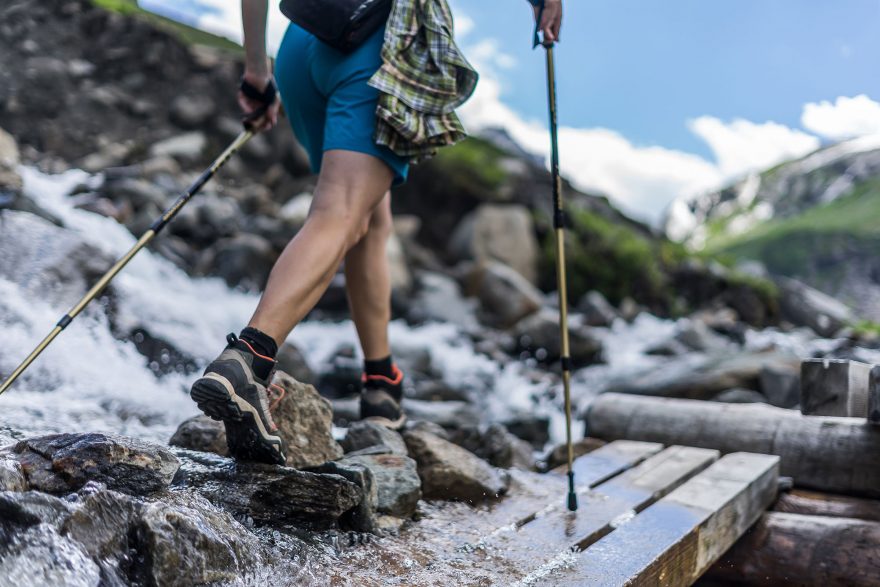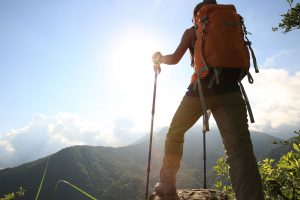
Hiking poles may be a good addition to your next hike, but like any piece of gear, they require proper technique and knowledge
Hiking poles (also called trekking poles, walking poles or hiking sticks) may give you the extra confidence and stability you need while trail hiking. Whether you’re out on a rugged steep trail or a level park path, you may find a set of hiking poles useful in many ways.
According to the Appalachian Trail Conservancy (ATC), hiking pole usage rates on the Appalachian Trail range from about 90 percent for thru-hikers to less than 15 percent for day hikers.
But there are both pros and cons to using hiking poles.

Pros of hiking poles
Help navigate trails
Since hiking poles give you much-needed stability, you’ll find them helpful when you run into obstacles on a trail. You can use your hiking poles to check water depth before crossing a stream or river. You can use your hiking poles as stabilizers to hop over puddles (like a “pole vault”) or to give you a push over larger rocks and logs.
Provide a good rhythm
Most hikers who use poles easily fall into a good rhythm on the trail. This rhythm helps with stability and confidence. You’ll want to plant your opposite hiking pole in time with your opposite foot. (Right foot, left pole; left foot, right pole; etc.) When the motion becomes natural to you, you’ll be in a nice rhythm — keeping you comfortable on the trail and improving your posture.
Help relieve stress on joints
Hiking poles may help you relieve stress on your joints — especially your knees. When you’re going downhill or uphill, your hiking poles can absorb some of the stress.
Can be used to help you rest
Especially when you’re hiking with a backpack, resting regularly will help alleviate fatigue. By leaning on your hiking poles, they’ll help your tired body get a little relief — even if it’s just for a couple of minutes.
Useful for more than hiking
Your hiking poles can be useful for a lot of things other than hiking — such as making a shelter in an emergency situation by draping a tarp over the poles like a tent. You can also use your poles to help clear a path in thick brush, to defend yourself from a snake or to make an essential first-aid tool, like a make-shift splint or stretcher.

Cons of hiking poles
May lead to injury
If your poles are too tall or too short, it could lead to back pain and/or other muscle and joint discomfort. Your hiking poles should be the right height for you. Generally, your pole height should be the height from the top of your palm — when your arm is at your side — with your forearm held out in front of you at a 90-degree angle. Improper use of your pole’s wrist straps could also lead to injury. If you fall, your wrist could get trapped if you’re holding the poles incorrectly.
Require more energy
Although using more energy can help you burn more calories, know that using hiking poles involves your upper body muscles — shoulders and arms — as well as your lower body muscles. So, when you’re hiking with poles, your body will naturally require more energy.
They tie up your hands
When you’re out on the trail, both of your hands are tied up using your hiking poles. If you want to take a photo or drink some water, you’ll have to do so around your hiking poles. This can be annoying when your poles are dangling on your wrists while you’re trying to drink from a water bottle or trying to get that good nature shot.
Can be expensive
Although there are a variety of cheaper hiking poles available, a good, lightweight set of hiking poles can cost more than $100. That’s a big investment. If you lose one of your poles, it’ll cost you a lot to replace it.
Can impact the environment
Hiking poles can leave a visible impact on trails and surrounding terrain — like holes in the ground that could damage adjacent vegetation. Some hiking poles with certain types of tips can even leave white scratches on rocks and detract from the wilderness experience. The ATC recommends several measures to mitigate the environmental impact of trekking poles in accordance with Leave No Trace principles of low-impact backcountry recreation.
Hiking poles may be a good addition to your next hike. But like any piece of hiking gear, using them efficiently requires proper technique and knowledge.
Suzanne Downing is an outdoor writer and photographer in Montana with an environmental science journalism background. Her work can be found in Outdoors Unlimited, Bugle Magazine, Missoulian, Byline Magazine, Communique, MTPR online, UM Native News, National Wildlife Federation campaigns and more.
 Your Privacy Choices
Your Privacy Choices